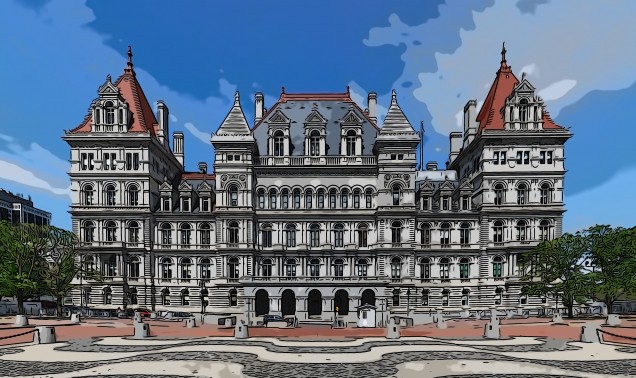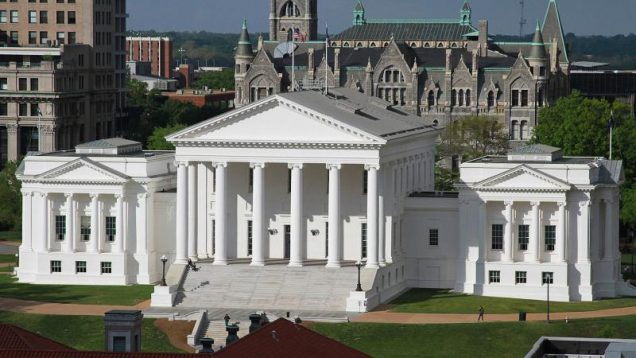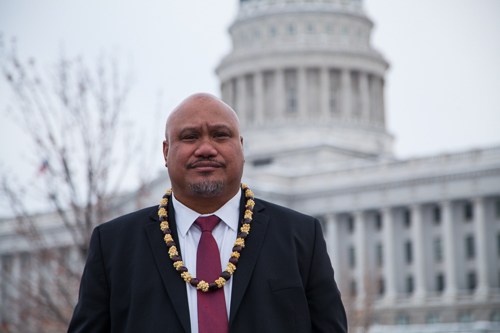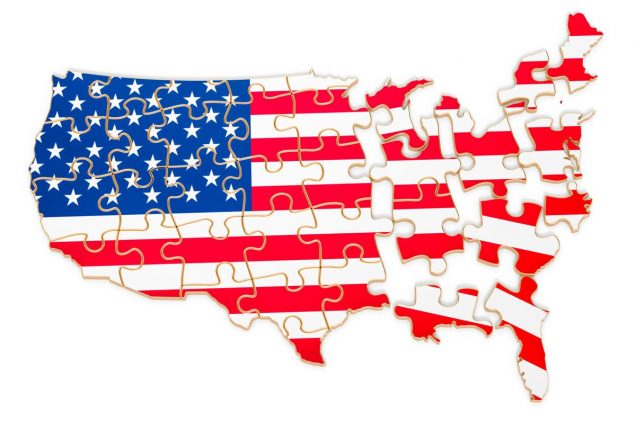Category: Federal Legislation
The Idiosyncrasies of Imbler: Absolute Immunity for Prosecutors Makes Absolutely No Sense
Supreme Court Justice Robert H. Jackson once observed that: “The prosecutor has more control over life, liberty, and reputation than any other person in America.” But with great power does not necessarily come great responsibility. When prosecutors present fabricated evidence and false testimony, make false statements, suborn or coerce perjury, conspire with a judge to predetermine the outcome of a case, withhold exculpatory evidence in a death penalty case, destroy exculpatory evidence, deny a speedy trial, and even violate a citizen’s right to be free from involuntary servitude, courts have held prosecutors are absolutely immune from civil liability. This immunity originates from the 1976 Supreme Court decision of Imbler v. Pachtman. In that case, Richard Pachtman, a prosecutor, withheld evidence that confirmed the alibi of a defendant in a murder trial, Paul Imbler, resulting in Imbler’s wrongful conviction. Yet, the Supreme Court held that Pachtman had absolute immunity from Imbler’s civil suit. The Imbler Court found support for absolute prosecutorial immunity in the “common law,” “history,” and “public policy.” Yet nearly half a century after Imbler, neither the common law, history, nor sound public policy provide continued support for absolute prosecutorial immunity.
The Imbler Court argued it was “well settled” that absolute immunity for prosecutors was “the common law rule.” In support of this claim, the Court cited a handful of lower court cases the earliest of which was decided in 1933. But none of these cases referenced English common law. At common law, absolute prosecutorial immunity was impossible as there was no such thing as a public prosecutor. Rather, private parties “prosecuted criminal wrongs which they suffered.” The public prosecutor was a “historical latecomer” who “did not emerge” in England until the “the Office of Director of Public Prosecutions” was established in 1879.
Even after public prosecution began in the U.S., as Justice Scalia recognized in his 1997 concurrence in Kalina v. Fletcher, there was “no such thing as absolute prosecutorial immunity.” Rather, prosecutors could be sued for malicious prosecution. For example, in 1854, the Massachusetts Supreme Judicial Court held that a prosecutor accused of lying did not have absolute immunity and could be prosecuted for “malicious” acts. The first U.S. court case granting prosecutors absolute immunity was handed down by the Indiana Supreme Court in 1896. That decision, which “became the clear majority rule” across the U.S. in the decades after it was decided, mistakenly concluded that the 1854 Massachusetts Supreme Judicial Court verdict which allowed for prosecutors to be sued for lying had in fact established that prosecutors were entitled to absolute immunity. Consequently, as Justice Scalia pointed out, Imbler was premised upon “a common-law tradition” that “was not even a logical extrapolation from then-established immunities.” At English common law, there was no such thing as a public prosecutor and throughout all of U.S. history until well after Reconstruction, public prosecutors had “the equivalent of qualified immunity” making them liable to suit for malicious acts.
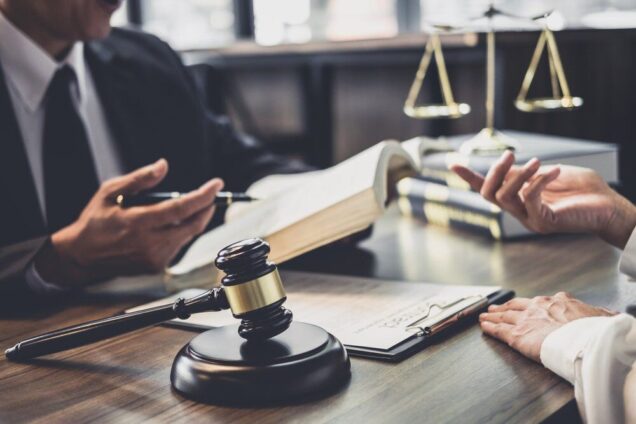 The Imbler Court also made a historical argument in favor of absolute immunity for prosecutors, claiming that the Reconstruction Congress did not intend for the 1871 Civil Rights Act to be read to mean what it plainly says that “every person” acting under color of law who violates a U.S. citizen’s constitutional rights is subject to suit. Rather, according to the Imbler majority, when the Reconstruction Congress referred to “every person” they did not mean to include prosecutors. The Court produced no evidence from the legislative history of the 1871 Act to support this conclusion. Given that no U.S. court had ever granted absolute immunity to a prosecutor until 1896, it is impossible that the Reconstruction Congress had this non-existent immunity in mind when they were legislating in 1871. Justices Thurgood Marshall, Blackmun, Brennan, Scalia, and Thomas have all since ridiculed Imbler’s revisionist history. Moreover, the 1871 Civil Rights Act was passed in part to remedy “Southern prosecutors’ aggressive abuse of the judicial process” to “thwart Reconstruction and the enforcement of federal civil rights laws.” In just one Southern state, over 3,000 Union soldiers were prosecuted. The Civil Rights Act exposed Southern prosecutors to civil liability to prevent federal officials from being subjected to malicious and baseless prosecutions “for arresting southern violators of the Civil Rights Acts.” The Imbler Court did not consider this history, refusing to construe the text of the Civil Rights Act “as stringently as it reads,” and instead implanting into the heart of the Civil Rights Act a rule of absolute immunity even though the Imbler Court acknowledged that the law “on its face, admits of no immunities.”
The Imbler Court also made a historical argument in favor of absolute immunity for prosecutors, claiming that the Reconstruction Congress did not intend for the 1871 Civil Rights Act to be read to mean what it plainly says that “every person” acting under color of law who violates a U.S. citizen’s constitutional rights is subject to suit. Rather, according to the Imbler majority, when the Reconstruction Congress referred to “every person” they did not mean to include prosecutors. The Court produced no evidence from the legislative history of the 1871 Act to support this conclusion. Given that no U.S. court had ever granted absolute immunity to a prosecutor until 1896, it is impossible that the Reconstruction Congress had this non-existent immunity in mind when they were legislating in 1871. Justices Thurgood Marshall, Blackmun, Brennan, Scalia, and Thomas have all since ridiculed Imbler’s revisionist history. Moreover, the 1871 Civil Rights Act was passed in part to remedy “Southern prosecutors’ aggressive abuse of the judicial process” to “thwart Reconstruction and the enforcement of federal civil rights laws.” In just one Southern state, over 3,000 Union soldiers were prosecuted. The Civil Rights Act exposed Southern prosecutors to civil liability to prevent federal officials from being subjected to malicious and baseless prosecutions “for arresting southern violators of the Civil Rights Acts.” The Imbler Court did not consider this history, refusing to construe the text of the Civil Rights Act “as stringently as it reads,” and instead implanting into the heart of the Civil Rights Act a rule of absolute immunity even though the Imbler Court acknowledged that the law “on its face, admits of no immunities.”
Imbler’s final justification for its ruling was a “public policy” argument that absolute immunity was necessary to protect “honest prosecutors” from being “constrained” in their actions by the prospect of civil liability. But absolute immunity unnecessarily defends deliberately dishonest prosecutors. The Imbler Court itself acknowledged that absolute immunity “does leave the genuinely wronged defendant without civil redress against a prosecutor whose malicious or dishonest action deprives him of liberty.”
The record of wrongful convictions in which prosecutorial misconduct played a decisive role since Imbler overwhelmingly confirms this unconscionable reality. Over 2,700 wrongful convictions have been recorded with prosecutors committing misconduct in 30% of those cases with the real total likely far exceeding that amount. The most recent national study of prosecutorial that took place over two decades ago found over 11,000 cases of prosecutorial misconduct with over 2,000 cases resulting in reduced sentences, dismissed charges, or reversed convictions. Wrongfully convicted people have spent tens of thousands of years in prison collectively for crimes they did not commit since Imbler and many guilty persons have remained free to commit more crimes. Worse still, prosecutorial misconduct was implicated in over 550 death penalty reversals or 5.6% of all death penalty cases. In federal wrongful conviction cases, according to the National Registry of Exonerations, prosecutors commit misconduct “more than twice as often as police” and “seven times as often as police” in federal white-collar cases. Yet, all prosecutors at the federal level and most at the state level receive more immunity from suit than police officers who receive qualified immunity. Providing qualified immunity to prosecutors, the type of immunity that all executive officials enjoyed when the Reconstruction Congress passed the Civil Rights Act of 1871, would protect honest prosecutors from frivolous suits while at the same time allowing the wrongfully convicted to hold prosecutors accountable for clearly established violations of constitutional rights.
The basic public policy error of the absolute immunity of Imbler is that it shields from liability all deliberately dishonest acts committed by prosecutors. It is one thing to argue that honest mistakes made by prosecutors acting in good faith should be immune from suit, but the Imbler Court took this too far and provided absolute immunity from suit for intentional bad faith acts committed by prosecutors that violate constitutional rights. The Imbler majority argued that prosecutors would be accountable through other means such as criminal liability and professional discipline. But only one prosecutor has ever been jailed for misconduct for a period of just 10 days, far shorter than the nearly 25 years the person whom he helped wrongfully convict spent in prison. Only 4% of prosecutors whose conduct played a role in securing wrongful convictions have been disciplined. One study of over 200 Justice Department cases of prosecutorial misconduct found zero instances of misconduct by federal prosecutors that resulted in disbarment. The public policy results of Imbler’s rule of absolute immunity for prosecutors over the past five decades confirm the old axiom that “absolute power corrupts absolutely.” Absolute immunity is simply too much power for the most powerful people in the U.S. criminal justice system to possess.
Imbler’s reasoning is non-sensical and utterly antithetical to a government “of laws and not of men” in which no official is “so high that he is above the law.” Imbler should be overturned by the Supreme Court. If the Supreme Court does not overturn Imbler, then, as Judge James C. Ho of the Fifth Circuit recently observed, Congress can abolish absolute immunity “anytime it wants to do so” by clarifying that the 1871 Civil Rights Act was never intended to idiosyncratically allow prosecutors to flout the rule of law with impunity.
 William Bock is a visiting student at Boston University School of Law and anticipates graduating from the University of Michigan Law School in May 2024.
William Bock is a visiting student at Boston University School of Law and anticipates graduating from the University of Michigan Law School in May 2024.
Congestion Pricing: Addressing The True Cost of Cars
One of the most heartening social trends of the last couple of years has been a recognition of the true costs of car use in cities. Whether approaching it from the stance of climate change, health effects from air quality, physical safety on the roads, or social fragmentation from structures that isolate and alienate people, it has become increasingly clear that we do not properly value our roads. One policy with great potential to address all these concerns, while generating considerable revenue that could support mass transit in cities, is congestion pricing of key roads in urban centers.
 The idea behind congestion pricing is that roadways are incredibly valuable real estate, which people do not pay to use (outside of some tolling on bridges and specific toll roads). The free use of the roads imposes significant social costs on the city's inhabitants through bumper-to-bumper traffic, costing people time, and polluting the air. A congestion pricing system would impose a toll on entrants to designated zones. This would reduce traffic by imposing the true costs of using the road, and hopefully, diverting people to use mass transit or other forms of transportation. The beneficial effects would range from clearing congestion, to reducing air pollution, to generating significant revenue for the city.
The idea behind congestion pricing is that roadways are incredibly valuable real estate, which people do not pay to use (outside of some tolling on bridges and specific toll roads). The free use of the roads imposes significant social costs on the city's inhabitants through bumper-to-bumper traffic, costing people time, and polluting the air. A congestion pricing system would impose a toll on entrants to designated zones. This would reduce traffic by imposing the true costs of using the road, and hopefully, diverting people to use mass transit or other forms of transportation. The beneficial effects would range from clearing congestion, to reducing air pollution, to generating significant revenue for the city.
This is no longer merely a thought experiment either. Notably, cities including London, Stockholm, and Singapore, have all implemented congestion pricing in their city centers to great positive effect. They generally see reduced car congestion, but also interestingly, greater total numbers of people accessing the city, as they come in via alternate methods. This increases economic value to the city without imposing any of the normal car related costs.
No American city has successfully implemented this policy yet, but New York is currently in the middle of a now 5 year long battle to try. In 2019, the New York State legislature passed, in the state budget, a law permitting the city of New York to implement a congestion pricing plan. Curiously, New York City does not control its own road system, and is therefore dependent on the state to give permission to implement such a project. This is relatively common in the U.S. and is in tension with the age-old principle of local control. It also raises a potential problem where a star city in a state drives a significant portion of that state’s revenue, but has strong political disagreements with the state government. In New York the success of the plan at the state level was over 50 years in the making. New York State had frequently prevented the city from implementing similar congestion pricing programs in the past, when the city had tried to reduce traffic.
Despite state approval, congestion pricing in New York has been stuck in limbo, in part due to federal law. Title 23 of the Federal Code prohibits municipalities from imposing tolls on roads constructed or maintained with federal funding, which include several New York City roads. To impose tolls, New York had to enlist in the Federal Highway Administration's Value Pricing Pilot Program (VPPP), which gives up to 15 cities or states special permission to experiment with toll related projects on federally funded roads. Congestion pricing plan falls under the purview of the National Environmental Protection Act (NEPA) because it is enrolled in the VPPP.
Passed in 1970, NEPA mandates environmental review of federal projects. While proponents argue that NEPA is an essential defense for the environment from human exploitation (both for its own sake and also to protect our habitat), critics traditionally argue it prevents profitable projects. Now environmentally minded advocates are increasingly frustrated with NEPA’s requirements. They argue NEPA’s onerous procedural requirements, which often require millions of dollars and years of effort, are inhibiting projects that would benefit the environment, violating its fundamental purpose.
 It is clearly the case in New York right now that the city is suffering from these unnecessary delays. It took 2 full years just for the federal government to determine whether the appropriate environmental review was a relatively basic Environmental Assessment, or a complete Environmental Impact Assessment for the project and another 2 years to issue the determination report. Now, going on 5 years from initial passage, the city is still waiting for a final determination if the project is viable. All of this for a project that requires the city to build almost no physical infrastructure, and would dramatically reduce emissions and air pollution by reducing the number of cars driving in New York.
It is clearly the case in New York right now that the city is suffering from these unnecessary delays. It took 2 full years just for the federal government to determine whether the appropriate environmental review was a relatively basic Environmental Assessment, or a complete Environmental Impact Assessment for the project and another 2 years to issue the determination report. Now, going on 5 years from initial passage, the city is still waiting for a final determination if the project is viable. All of this for a project that requires the city to build almost no physical infrastructure, and would dramatically reduce emissions and air pollution by reducing the number of cars driving in New York.
The FHWA can remedy this issue by assigning congestion pricing projects a Categorical Exclusion (CE). A CE is used for projects that are known not to have negative environmental impacts. It exempts them from the entire Environmental Impact Statement and Environmental Assessment process. It is commonly used in projects where there will not be significant physical infrastructure created, much like the congest program. The programs would still have to present reasons why they should be granted the exclusion, so this will not totally eliminate any environmental review, but it will bring the level of review in line with the risks that the project actually presents.
New York’s experience shows the complex thicket of legislation and regulation that creative environmentalists must navigate in order to successfully pursue valuable projects. Congestion pricing is a perfect example because it is so cheap to implement, the primary difficulty should be political, in getting state legislatures to pass laws giving permission for cities to enact it. More American cities including San Francisco, Los Angeles, and Seattle have shown interest but have shown extreme caution in part because they know how difficult the implementation will be. Instead of trusting legislators and representatives to work on behalf of city residents, needlessly complex and blunt regulations are stepping in the way and forcing us to continue to choke cities in idling car fumes.
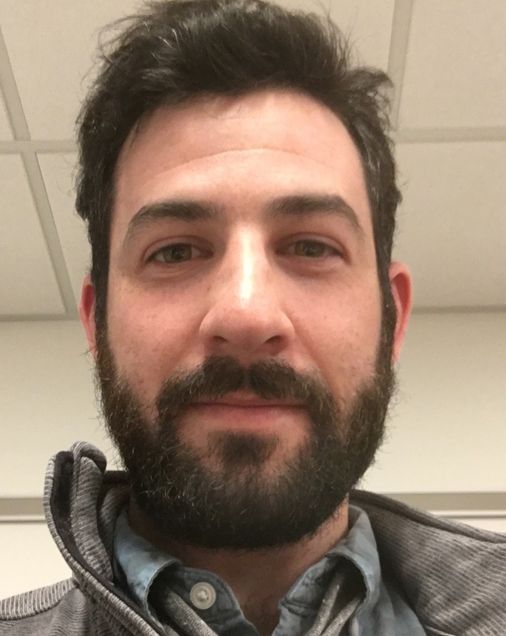 Peter Kaplan anticipates graduating from Boston University School of Law in May 2024.
Peter Kaplan anticipates graduating from Boston University School of Law in May 2024.
Revenge Porn and Deep Fake Technology: The Latest Iteration of Online Abuse
Revenge Porn
The rise of the digital age has brought many advancements to our society. But it has also enabled new forms of online harassment and abuse. Revenge porn (otherwise referred to as image-based sexual abuse or nonconsensual pornography) is a type of gender-based abuse in which sexually explicit photos or videos are shared without the consent of those pictured. The prevalence of cell phones and user-generated content websites has turned revenge porn into a common phenomenon. While some legislation has been passed to meet this rising threat, technology has evolved to the point that many of these statutes no longer meet the challenge of the current environment. State legislators have left wide loopholes in their revenge porn statutes, and the rise in Artificial Intelligence (AI) has created a new brand of revenge porn missing entirely from state statutes. Furthermore, the federal government has so far failed to make revenge porn in any form a criminal offense.
 As of late 2022, forty-eight states and D.C. have enacted some form of revenge porn legislation (the two states that have yet to enact formal revenge porn statutes are Massachusetts and South Carolina). Some of these statutes criminalize revenge porn, while others allow victims to recover monetary damages under existing civil causes of action. While it is encouraging to see so many states act, efforts at the federal level have repeatedly encountered hurdles. Each time, those efforts stalled due to First Amendment concerns. Representative Jackie Speier (D-CA) crafted the Ending Nonconsensual Online user Graphic Harassment (ENOUGH) Act in 2017 to make revenge porn a federal crime, but it died in committee and expired at the end of the 115th Congress. In 2018, Senator Ben Sasse (R-NE) introduced the Malicious Deep Fake Prohibition Act, criminalizing the creation or distribution of all fake electronic media records that appear realistic (essentially, banning deep fake technology altogether). The act expired at the end of 2018 with no cosponsors. In the past four years, Representative Yvette D. Clarke (D-NY) introduced the DEEP FAKES Accountability Act twice – the first in 2019 (H.R. 3230, which died in committee at the end of 2020) and the second in 2021 (H.R. 2395, which again died in committee at the beginning of 2023). In February 2023, Senators Amy Klobuchar (D-MN) and John Cornyn (R-TX) introduced to the Senate Judiciary Committee the Stopping Harmful Image Exploitation and Limiting Distribution (SHIELD) Act (utilizing text originally introduced by Rep. Jackie Speier). Though it should be noted that the proposed SHIELD Act would not criminalize the rising threat of AI-generated pornographic images.
As of late 2022, forty-eight states and D.C. have enacted some form of revenge porn legislation (the two states that have yet to enact formal revenge porn statutes are Massachusetts and South Carolina). Some of these statutes criminalize revenge porn, while others allow victims to recover monetary damages under existing civil causes of action. While it is encouraging to see so many states act, efforts at the federal level have repeatedly encountered hurdles. Each time, those efforts stalled due to First Amendment concerns. Representative Jackie Speier (D-CA) crafted the Ending Nonconsensual Online user Graphic Harassment (ENOUGH) Act in 2017 to make revenge porn a federal crime, but it died in committee and expired at the end of the 115th Congress. In 2018, Senator Ben Sasse (R-NE) introduced the Malicious Deep Fake Prohibition Act, criminalizing the creation or distribution of all fake electronic media records that appear realistic (essentially, banning deep fake technology altogether). The act expired at the end of 2018 with no cosponsors. In the past four years, Representative Yvette D. Clarke (D-NY) introduced the DEEP FAKES Accountability Act twice – the first in 2019 (H.R. 3230, which died in committee at the end of 2020) and the second in 2021 (H.R. 2395, which again died in committee at the beginning of 2023). In February 2023, Senators Amy Klobuchar (D-MN) and John Cornyn (R-TX) introduced to the Senate Judiciary Committee the Stopping Harmful Image Exploitation and Limiting Distribution (SHIELD) Act (utilizing text originally introduced by Rep. Jackie Speier). Though it should be noted that the proposed SHIELD Act would not criminalize the rising threat of AI-generated pornographic images.
Rise of Deep Fake Technology
 What began as sharing consensually obtained images beyond their intended viewers has evolved into more insidious and complex crimes. Hackers have started accessing private devices to steal intimate photos for the purpose of blackmailing victims with the threat of sharing those photos online. And the rise of Artificial Intelligence (AI) has created a new type of revenge porn: deep fakes.
What began as sharing consensually obtained images beyond their intended viewers has evolved into more insidious and complex crimes. Hackers have started accessing private devices to steal intimate photos for the purpose of blackmailing victims with the threat of sharing those photos online. And the rise of Artificial Intelligence (AI) has created a new type of revenge porn: deep fakes.
We have now entered a new phase of exploitation: AI-manufactured nude photos. Technology users can now utilize the photos of real people to create pornographic images and videos. There are two types of AI-generated images that relate to the problem of revenge porn: “deep fakes” and “nudified” images. Deep fakes are created when an AI program is “trained” on a reference subject. Uploaded reference photos and videos are “swapped” with target images, creating the illusion that the reference subject is saying or participating in actions that they never have. U.S. intelligence officials acknowledged deep fake technology in their annual “worldwide threat assessment” for its ability to create convincing (but false) images or videos that could influence political campaigns. In the context of revenge porn, pictures and videos of a victim can be manipulated into a convincing pornographic image or video. AI technology can also be used to “nudify” existing images. After uploading an image of a real person, a convincing nude photo can be generated using free applications and websites. While some of these apps have been banned or deleted (for example, DeepNude was shut down by its creator in 2019 after intense backlash), new apps pop up in their places.
This technology will undoubtedly exacerbate the prevalence and severity of revenge porn – with the line of what’s real and what’s generated blurring together, folks are more at risk of their image being exploited. And this technology is having a disproportionate impact on women. Sensity AI tracked online deep fake videos and found that 90%-95% of them are nonconsensual porn, and 90% of those are nonconsensual porn of women. This form of gender-based violence was recently on display when a high-profile male video game streamer accessed deep fake videos of his female colleagues and displayed them during a live stream.
This technology also creates a new legal problem: does a nude image have to be “real” for a victim to recover damages? In Ohio, for instance, it is a criminal offense to knowingly disseminate “an image of another person” who can “be identified form the image itself or from information displayed in connection with the image and the offender supplied the identifying information” when the person in the image is “in a state of nudity or is engaged in a sexual act.” It is currently unclear if an AI-generated nude image constitutes “an image of another person...” under the law. Cursory research did not unearth any lawsuits alleging the unauthorized use of personal images in AI-generated pornography. In fact, after becoming a victim to deep fake pornography herself, famed actress Scarlett Johansson told the Washington Post that she “thinks [litigation is] a useless pursuit, legally, mostly because the internet is a vast wormhole of darkness that eats itself.” However, in early 2023, artists have filed a class-action lawsuit against companies utilizing Stable Diffusion for copyright violations. This lawsuit may signal that unwilling participants in AI-generated content may could find relief in the legal system.
Some states have tackled head-on the issue of deep fake technology as it relates to revenge porn and sexual exploitation. In Virginia, it is a Class 1 misdemeanor for the unauthorized dissemination or selling of a sexually explicit video or image of another person created by any means whatsoever (emphasis added). The statute goes on to state that “another person” includes a person whose image was used in creating, adapting, or modifying a video or image with the intent to depict an actual person and who is recognizable as an actual person by the person's face, likeness, or other distinguishing characteristic. But this Virginia law is not without fault. The statute states that the image must be of a person’s genitalia, pubic area, buttocks, or breasts. Therefore, an image of a person in a compromising position or that is merely sexually suggestive would likely not be covered by this statute.
Current Remedies are Insufficient
Revenge porn victims often bring tort claims, which may include invasion of privacy, intrusion on seclusion, intentional/negligent infliction of emotional distress, defamation, and others. Specific revenge porn statutes also allow for civil recovery in some states. But revenge porn statutes have flaws. In an article authored by Professor Rebecca Defino, there are three commonly cited critiques to revenge porn statutes. The first is that many of these statutes have a malicious intent or illicit motive requirement, which requires prosecutors to prove a particular mens rea. (921; see the aforementioned Ohio statute; Missouri criminal statute; Okla. Stat. tit. 21, § 1040.13b(B)(2)). Second, many revenge porn statutes include a “harm” requirement, which is difficult to prove and requires victims to expose even more of their private life in a public arena. (921). And finally, the penalties are weak. (921). And even if a victim wins a case against a perpetrator, jail time for the perpetrator or small monetary settlements don’t provide victims what they often really desire – for their images to be taken off the Internet. The Netflix series called The Most Hated Man on the Internet shows the years long and deeply expensive journey to remove photos from a revenge porn website. While state revenge porn laws may assist victims with finding recourse, the process of removing images post-conviction can still be traumatizing and time-consuming.
While deep fake legislation is considered (or stalled) through state and federal governments, the private sector may be able to provide some solutions. A tool called “Take It Down” is funded by Meta Platforms (the owner of Facebook and Instagram) and operated by the National Center for Missing and Exploited Children. The site allows anonymous individuals to create a digital “fingerprint” of real or deepfake image. That “fingerprint” is then uploaded to a database, which certain tech companies (including Facebook, Instagram, TikTok Yubo, OnlyFans, and Pornhub) have agreed to participate in, that will remove that image from their services. This technology is not without its own limitations. If the image is on a non-participating site (currently, Twitter has not committed to the project) or is sent via an encrypted platform (like WhatsApp), the image will not be taken down.
Additionally, if the image has been cropped, edited with a filter, turned into a meme, had an emoji added, or altered in other ways, the image is considered new and requires its own “fingerprint.”
While these are not easy problems to solve, the federal government can and should criminalize revenge porn, including AI-generated revenge porn. A federal statute would provide a stronger disincentive to create pornographic deep fakes through the threat of investigations by the FBI and prosecution by the Department of Justice. (927-928). Law professor Rebecca A. Delfino drafted the Pornographic Deepfake Criminalization Act, which makes the creation or distribution of pornographic deepfakes unlawful and allows the government to impose jail time and/or fines on defendants found guilty of the crime. (928-930). Perhaps more impactfully, the proposed act allows courts to issue the destruction of the image, compel content providers to remove the image, issue an injunction to prevent further distribution of the deep fake image, and award monetary damages to the victim. (930). The law is an imperfect tool in fighting against revenge porn and AI-generated pornographic deep fakes. But to the extent that legislators can provide additional support to victims, it is their obligation to do so.
 Kara Kelleher graduated from Boston University School of Law with a juris doctor in May 2023.
Kara Kelleher graduated from Boston University School of Law with a juris doctor in May 2023.
Voter Suppression Laws in the Wake of Democratic Control of the Presidency and Senate
Georgia gained national attention in the 2020 election when the predominantly red state broke its 24-year streak of voting for Republican candidates in U.S. Presidential Elections. It went on to make history in early 2021 when the electorate flipped the U.S. Senate and elected Rev. Raphael Warnock and Jon Ossoff to the U.S. Senate, respectively the first Black and Jewish Senators from Georgia.
A large part of this victory both in the White House and the Senate is attributed to Stacey Abrams, the Democrat gubernatorial candidate in Georgia’s 2018 election. Abrams’ gubernatorial campaign was unsuccessful, in large part because of voter suppression, but rather than wallow in defeat and fade into the background, Abrams became a loud, powerful voice—speaking against voter suppression and registering hundreds of thousands of voters in Georgia.
And now Republicans—in Georgia and across the nation—formally responded, pushing a huge new wave of voter suppression tactics in the name of “election integrity.”
S.B. 71
Among other legislation, Republicans in the Georgia Senate have proposed S.B. 71, which would change the definition of absentee voter entirely. For the past 15 years or so, Georgia has been a “no excuse needed” absentee voting state, but this bill would require people who wish to vote absentee to
- Be physically absent from their precinct during the election;
- Be able to perform any of the “official acts or duties” connected to the election;
- Be absent because of physical disability or because you’re required to give constant care to someone who is disabled;
- Be observing a religious holiday;
- Be required to remain on duty for the “protection of the health, life, or safety of the public”; or
- Be at least 65-years-old.
These extremely limited exceptions would put even more emphasis on the luxury and privilege of time. Many people cannot take an hour (or more) out of their daily schedules—balancing child care, housing matters, and work among the other minutiae of modern life—to go to the polls. The oft-used argument to that is “well, there are plenty of precincts where you can get in and out in 10 minutes.” And while that may be accurate, the problem is inherent in the argument itself: that it isn’t true of every precinct; and issues with fewer voting machines, voter purges, and, therefore, long waits tend to disproportionately affect liberal-voting communities in Republican controlled states.
 In Georgia, it seems like the Republicans are worried they are seeing the writing on the wall after the voter turnout in the 2020 Presidential and Senatorial elections. Though not an overwhelming victory in any of the elections, the Democrats mustered enough of a majority to win, and with continued growth in urban areas and a push for even more change in the future, it’s incredibly likely that Georgia will continue to vote blue in the future. The state has been trending that way for years, and the 2020 election could well portend what is in store for conservatives in Georgia.
In Georgia, it seems like the Republicans are worried they are seeing the writing on the wall after the voter turnout in the 2020 Presidential and Senatorial elections. Though not an overwhelming victory in any of the elections, the Democrats mustered enough of a majority to win, and with continued growth in urban areas and a push for even more change in the future, it’s incredibly likely that Georgia will continue to vote blue in the future. The state has been trending that way for years, and the 2020 election could well portend what is in store for conservatives in Georgia.
Other Voter Suppression Legislation
Throughout the nation, state legislatures have begun putting forth bills that would restrict voting access—in fact, over four times more legislation that would restrict voting has been proposed than was proposed this time last year.
Georgia is not alone in limiting absentee voting. Nine other states have proposed bills that would either eliminate “no excuse” voting or crack down on the requirements for absentee voting where “excuse” voting is already in place. Other bills make it more difficult to obtain ballots in the first place by changing the laws concerning permanent early voter lists. Some measures go so far as to eliminate permanent early voter lists (which would force people now on those lists to take more steps to vote every year; Arizona S.B. 1678, Hawaii H.B. 1262, and New Jersey S.B. 3391) while others would reduce how long someone remains on the permanent absentee voter list (Florida S.B. 90).
Other proposals concern stricter voter ID requirements—a long contentious aspect of voter suppression. States that do not currently require photo IDs to vote are considering requiring them in the future, other states are trying to restrict what kinds of photo IDs can be used (New Hampshire H.B. 429, Mississippi H.B. 543), and some would force voters to include a photocopy of their ID with their absentee ballots (Texas S.B. 1). Requiring voter ID (and particularly certain types of ID) is problematic because there are not enough opportunities for people to obtain IDs—lunch hour spent at the DMV, anyone?—and cost barriers make obtaining an ID unfeasible for many disenfranchised populations. This also ties in with the legislative efforts to reduce voter registration opportunities, whether that be election day registration or limiting or reducing automatic voter registration.
Lastly, some state legislatures have decided that amplifying voter purge practices is the way forward. The practice is already flawed (and usually ineffective and unnecessary), but the proposed legislation would expand the scale of extant purges or adopt procedures that would likely result in improper purges. Texas legislators have sent a bill to the governor that would add new criminal penalties to voting processes, enhance partisan poll-watching, and ban measures previously enacted to increase access to voting. New Hampshire has gone so far as to propose a bill that would violate the National Voter Registration Act.
Staying on our toes
Although some legislation has been proposed to expand access to voting, the backlash and restrictions are what anyone concerned with protecting the right to vote should be worried about. The proposed restrictions on voting would remove people from voter rolls, make it harder to vote in person by heightening ID requirements, erect further barriers to obtaining IDs, severely limit who can vote absentee, and add arbitrary hurdles to voting by mail generally. The individual right to vote is integral to securing and maintaining American democracy, and efforts to build barriers that would make it nearly impossible for American citizens to vote are plainly wrong. Preventing voter fraud is important, but using rhetoric about “election integrity” to justify disenfranchising certain populations is classist, racist, and morally repugnant, and that is without touching the constitutional and legal issues surrounding the matter. Already, the Democrat-controlled U.S. Congress is taking steps to prevent the voter suppression promulgated by this wave of state legislation. What Republicans who are worried about votes in the hands of marginalized communities do not realize is that it isn’t a matter of barriers and restrictive legislation, it’s a matter of time. Georgia was one of the first dominoes to fall, but it won’t be the last, especially with the federal government ready and willing to strengthen voting rights and access.
 Amelia Melas anticipates graduating from Boston University School of Law in May 2022.
Amelia Melas anticipates graduating from Boston University School of Law in May 2022.
Archegos Capital Management and Family Office Regulation Reform
Alexandria Ocasio Cortez (D-NY), who has been at the vanguard of the movement to eradicate preferential treatment for the rich, may soon score a win for that cause. In July 2021, the congresswoman introduced H.R. 4620, the Family Office Regulation Act of 2021. The bill, if enacted, would curb the preferential treatment family offices enjoy under the Investment Advisers Act of 1940. Over the past year, events in the family office industry reveal the possible exploitation of these entities, the potential risks to the financial system, and the need for reform.
What are family offices and why are they on Rep. Ocasio Cortez’s mind? Family offices are a little-known type of investment management entity that manage the assets of wealthy families. Only the owning family members may be clients of family offices and these entities may not hold themselves out as investment advisers to the public. Wealthy families enjoy the family office model because it offers highly customized wealth management. Furthermore, and key to the issue addressed by H.R. 4620, family offices do not need to register as investment advisers with the Securities Exchange Commission.
 In March 2021, Archegos Capital Management, a family office managing $20 billion in assets suffered a dramatic collapse causing several banks, primarily Credit Suisse and Nomura, to lose billions of dollars. The failure of Archegos has focused the attention of regulators, legislators and financial industry participants on family offices, which remain largely unregulated.
In March 2021, Archegos Capital Management, a family office managing $20 billion in assets suffered a dramatic collapse causing several banks, primarily Credit Suisse and Nomura, to lose billions of dollars. The failure of Archegos has focused the attention of regulators, legislators and financial industry participants on family offices, which remain largely unregulated.
The Investment Advisers Act of 1940 defines an investment adviser as “any person who, for compensation, engages in the business of advising others . . . as to the value of securities or as to the advisability of investing in, purchasing, or selling securities . . . .” Most investment management firms fall squarely within this definition. As a result, they are subject to the requirements and prohibitions imposed by the Advisers Act, including registration with and periodic examinations by the SEC. Family offices, like other private fund advisers of hedge funds, private equity funds, and venture capital funds, historically were exempt from registering with the SEC because these funds were not generally available to ordinary investors; the Advisers Act focus for protection. Private advisers could avoid registration with the SEC by accepting only accredited investors (high net worth individuals, investment professionals, or institutions), did not market their securities to the public, and constrained the resale of their securities. Although the Dodd-Frank Wall Street Reform and Consumer Protection Act repealed the private adviser exemption, it not only preserved favorable treatment for family offices, but it also directed the SEC to define “family office” and exclude it from the definition of the Advisers Act. The rationale for this carveout, the Family Office Rule, ostensibly was a recognition that “the Advisers Act is not designed to regulate the interactions of family members, and registration would unnecessarily intrude on the privacy of the family involved.” In reality, the Family Office Rule may have been the result of a successful lobbying effort by the family office industry.
The Family Office Rule has been tremendous boon to the family office industry. Family offices avoid the costly legal expenses associated with complying with the Advisers Act. Furthermore, family offices do not compromise their privacy by disclosing information about their investments to government regulators. Hedge fund investors have noticed the advantages family offices offer. Dozens of prominent hedge fund investors converted their funds into family offices. The family office model allows investors to take on more risk by abandoning cautious outside investors and avoiding any reporting requirements that may reveal risky investment strategies to regulators. Hedge fund investors have shown a willingness to return client funds to manage their own personal wealth under the family office model. The influx of former hedge fund investors into the family office space has led to more high-risk investments made by these entities.
 No person typifies the recent transformation of the family office industry better than Bill Hwang, the founder of Archegos. Hwang is a former hedge fund manager who amassed a personal fortune. After an insider trading scandal earned him a five-year ban on managing client funds, Hwang founded Archegos which he incepted with $200 million of his own money. From 2013 to 2021, Hwang deployed a highly successful, but equally risky investment strategy. He invested his entire portfolio in a handful of stocks. He used leverage, in the form of total return swaps, to magnify his exposure to those stocks. Total return swaps are derivative contracts in which banks agree to own assets for an investor and make payments to the investor based on the asset’s performance in exchange for fixed payments made by the investor. Investors do not need the funds to pay for the actual assets; they only need money to pay the bank the fixed payments determined by the contract. If the asset’s performance suffers, the investor must further compensate the bank for the negative returns. If the bank fears that the investor is unable to meet its obligations under a total return swap, the bank may sell the underlying asset. In March 2021 the share price of ViacomCBS, a key Archegos investment, dipped sharply. Two of the banks holding total return swap agreements with Hwang knew that this imperiled Archegos’ portfolio and began selling the stocks, driving down the value of the Archegos portfolio. Other banks followed suit, but some acted too slowly. The diminished value of Archegos’ portfolio left Hwang unable to pay the banks what he owed, causing billions of dollars in losses.
No person typifies the recent transformation of the family office industry better than Bill Hwang, the founder of Archegos. Hwang is a former hedge fund manager who amassed a personal fortune. After an insider trading scandal earned him a five-year ban on managing client funds, Hwang founded Archegos which he incepted with $200 million of his own money. From 2013 to 2021, Hwang deployed a highly successful, but equally risky investment strategy. He invested his entire portfolio in a handful of stocks. He used leverage, in the form of total return swaps, to magnify his exposure to those stocks. Total return swaps are derivative contracts in which banks agree to own assets for an investor and make payments to the investor based on the asset’s performance in exchange for fixed payments made by the investor. Investors do not need the funds to pay for the actual assets; they only need money to pay the bank the fixed payments determined by the contract. If the asset’s performance suffers, the investor must further compensate the bank for the negative returns. If the bank fears that the investor is unable to meet its obligations under a total return swap, the bank may sell the underlying asset. In March 2021 the share price of ViacomCBS, a key Archegos investment, dipped sharply. Two of the banks holding total return swap agreements with Hwang knew that this imperiled Archegos’ portfolio and began selling the stocks, driving down the value of the Archegos portfolio. Other banks followed suit, but some acted too slowly. The diminished value of Archegos’ portfolio left Hwang unable to pay the banks what he owed, causing billions of dollars in losses.
When the dust settled, it became clear that Hwang had obfuscated an extremely risky trading strategy not just from his financial system counterparts, but also from virtually all financial regulators. Archegos’ failure was reminiscent of the 2008 financial crisis, where losses at highly leveraged hedge funds contributed to the crisis and the failure of systematically important financial institutions. The 2008 financial crisis spurred reform aimed at improving regulators’ insight into private fund activity. Some now feel that the Archegos saga demonstrates that regulators are not able to assess the systemic risk that family offices impose on the financial system. Legislators like Rep. Ocasio Cortez have stepped forward to address that problem.
 H.R. 4620 limits the Family Office Rule to funds with $750 million or less in assets under management that are not subject to final orders for fraud, manipulation or deceit. The bill also excludes family offices that have less than $750 million in highly leveraged assets and those that the SEC determines engage in risky activities. If the bill becomes law, many family offices would be required to file an annual Form ADV, the registration statement that registered investment advisers complete each year.
H.R. 4620 limits the Family Office Rule to funds with $750 million or less in assets under management that are not subject to final orders for fraud, manipulation or deceit. The bill also excludes family offices that have less than $750 million in highly leveraged assets and those that the SEC determines engage in risky activities. If the bill becomes law, many family offices would be required to file an annual Form ADV, the registration statement that registered investment advisers complete each year.
H.R. 4620 is a well-crafted strategy to subsume family offices into the existing regulatory environment for investment advisers. It aligns the treatment of most family offices with the treatment applied to most investment advisers. By filing Form ADV, the SEC will have information about family offices including the identity of controlling persons, how operations are financed, the disciplinary history employees, and information about the private funds managed. The SEC uses the information on ADVs to develop risk profiles. It will conduct examinations on those family offices whose ADVs suggest misconduct or raise some other red flag. While no piece of legislation will ever completely eradicate wild risk-taking from the investment world, this measure could bring such activity in the family office industry out of the shadows and give regulators a fighting chance of addressing it before its negative effects are suffered throughout the financial system.
 Michael Murphy anticipates graduating from Boston University School of Law in May 2022.
Michael Murphy anticipates graduating from Boston University School of Law in May 2022.
U.S. Citizenship and Justice for American Samoa
 On March 16, 2021, Aumua Amata Coleman Radewagen, a non-voting congressional delegate for American Samoa, introduced House Resolution 1941 - To amend the Immigration and Nationality Act to waive certain naturalization requirements for United States nationals, and for other purposes. This bill would allow eligible U.S. Nationals in Outlying Possessions to become citizens upon establishing residence and physical presence in those territories. It would also waive certain other naturalization requirements for non-citizen nationals, who currently need to become a resident of a U.S. state to qualify. The mere existence of this bill raises questions about the nature of the relationship between America and its “Outlying Possessions” like American Samoa. Why are the inhabitants of Tutuila, the Manuʻa Islands, Rose Atoll, and Swains Island called “American” Samoans when they are not born with equal legal status to other Americans?
On March 16, 2021, Aumua Amata Coleman Radewagen, a non-voting congressional delegate for American Samoa, introduced House Resolution 1941 - To amend the Immigration and Nationality Act to waive certain naturalization requirements for United States nationals, and for other purposes. This bill would allow eligible U.S. Nationals in Outlying Possessions to become citizens upon establishing residence and physical presence in those territories. It would also waive certain other naturalization requirements for non-citizen nationals, who currently need to become a resident of a U.S. state to qualify. The mere existence of this bill raises questions about the nature of the relationship between America and its “Outlying Possessions” like American Samoa. Why are the inhabitants of Tutuila, the Manuʻa Islands, Rose Atoll, and Swains Island called “American” Samoans when they are not born with equal legal status to other Americans?
In 1900, the United States and the German Empire unceremoniously partitioned Samoa between themselves. Neither had conquered their respective portion from one another, the prior British claimants, or even the native population. By the dawn of the 20th Century, apparently, western dominion was such a foregone conclusion that neither empire bothered to do much actual colonizing. The U.S., the Kaiserreich, and the British Empire decided the fate of the Samoans in a Washington D.C. conference overseen by Oscar II, King of Sweden and Norway. No one invited any Samoans. The U.S. still claims sovereignty over its gains from this treaty. These five main islands (and two atolls) now constitute the unincorporated, unorganized territory of the United States known as American Samoa.
The United States possesses 16 territories, but only 5 are home to permanent populations. These are American Samoa, Guam, the Northern Mariana Islands, Puerto Rico, and the U.S. Virgin Islands. The Supreme Court decided the unincorporated status of these territories in the 1901 Insular Cases, summarized by Stacey Plaskett of the Atlantic:
In a series of highly fractured and controversial decisions known collectively as the Insular Cases, the Supreme Court invented an unprecedented new category of “unincorporated” territories, which were not on a path to statehood and whose residents could be denied even basic constitutional rights. Which territories the Court determined were “unincorporated” turned largely on the justices’ view of the people who lived there—people they labeled “half-civilized,” “savage,” “alien races,” and “ignorant and lawless.”
While the other 4 unincorporated territories face legal challenges, all except American Samoa are organized. The full U.S. constitution does not apply in organized territories, and their congressional delegates are nonvoting. However, residents of organized territories are at least American citizens. Unique among permanently populated U.S. territories, American Samoa’s people are not citizens. At birth, they receive the lesser status of non-citizen U.S. National. U.S. Nationals cannot vote in elections held in the 50 states. People born in other territories, like Puerto Rico, are citizens and can vote in these elections. American Samoa is the only permanently inhabited territory of the U.S. whose people are not American citizens.
Lesser voting rights are not the only difference between American citizens and nationals. Despite claims from sources such as the National Conference of State Legislatures that “There’s not much difference between the two designations,” American Samoans face unique legal challenges as described by Temple Law Professor Tom C.W. Lin:
However, unlike the other Territories, where Congress conferred citizenship to the people of each Territory, Congress enacted no such enabling act for the people of American Samoa. Accordingly, American Samoans are non-citizen nationals of the United States. They reside in an “interstitial” space in law and fact, with some, but not all, of the rights and privileges that accompany citizenship. As non-citizen nationals, American Samoans are ineligible for many government jobs, benefits, and privileges that are afforded only to citizens of the United States.
To be a second-class citizen, one has to at least be a citizen. In the current legal framework, U.S. national Samoans are second-class Americans.
This legal status is not simply a forgotten artifact of gilded-age American imperialism. In 2012 Leneuoti Tuaua, prohibited from police work in California because of his non-citizen national status, filed suit against the State Department and the Obama administration. His counsel argued that the citizenship clause of the 14th amendment (“All persons born or naturalized in the United States, and subject to the jurisdiction thereof, are citizens of the United States”) guaranteed those born in American Samoa citizenship without the need for approval by Congress. Citing the 1901 Insular Cases, the U.S. Court of Appeals for the District of Columbia ruled 3-0 that only Congress could grant citizenship to non-citizen nationals. The Supreme Court denied certiorari. In 2019, John Fitisemanu challenged the “federal policy [requirement] that his U.S. passport include a disclaimer in all capital letters that ‘THE BEARER IS A UNITED STATES NATIONAL AND NOT A UNITED STATES CITIZEN.’” His counsel too argued that the citizenship clause of the 14th Amendment guarantees birthright citizenship to American Samoans. A Utah district court agreed with Fitisemanu, but the 10th Circuit Court of Appeals reversed. The Fitisemanu plaintiffs sought a sought a rehearing en banc but the court denied the motion in December, 2021.
It is unlikely the current Supreme Court will grant certiorari. The Court has made its position clear: only Congress can alter the status of those born in unorganized territories. Another complication arises in that blanket citizenship does not see universal support among American Samoans. Along with religious concerns, some believe an organizing act would upset traditional land ownership. The islands’ government employs Samoan ancestry requirements to keep land in the hands of native families. These requirements would likely be held unconstitutional if all American Samoans were made citizens. This could potentially lead to wealthy outsiders and corporations buying out locals, threatening the American Samoans’ cultural and economic way of life. As such, Delegate Radewagen’s H.R. 1941 represents a worthy compromise. It would greatly reduce barriers to citizenship for U.S. National Samoans, while also preserving a legal system that allows them to carry on their traditional way of life. Delegate Radewagen’s proposed bill was sent to the House Subcommittee on Immigration and Citizenship in May 2021. Congress should pass this legislation to give American Samoans back the individual right to self-determination denied to them over 100 years ago.
 James Hallisey anticipates graduating from Boston University School of Law in May 2023.
James Hallisey anticipates graduating from Boston University School of Law in May 2023.
Book Review: Fighting Political Gridlock
by David J. Toscano
University of Virgina Press, 2021
ISBN: 9780813946467 (hardcover)
Over the last few days, I had the chance to read David J. Toscano’s excellent new book Fighting Political Gridlock: How States Shape Our Nation and Our Lives. From the dust jacket:
In this profoundly polarized era, the nation has been transfixed on the politics of Washington and its seemingly impenetrable gridlock. Many of the decisions that truly affect people’s lives, however, are being made not on the federal level but in the states. Faced with Washington’s political standoff, state governments are taking action on numerous vital issues, often with greater impact on citizens and their communities than from any decision made in D.C. Despite this, few Americans really understand their state governments or the issues they address. In Fighting Political Gridlock, David Toscano reveals how the states are working around the impasse in Washington and how state policies are increasingly shaping society.
Many people are fed up with the seemingly hopeless nature of the federal government. There is a lack of cooperation not just on important issues like immigration, the environment, and tax law—but also existential threats to the Republic like the deadly January 6th attack on the Congress.
The state governments, however, are filling the void by functioning as they were intended. This was especially true when faced by the global pandemic and a Trump White House that both undermined the government’s response to Covid-19 and at times actively worked against the efforts of the states.
Still, many people don’t realize how important state governments are to their day-to-day lives. Part of the problem is many people do not understand the difference between state and federal government. When I worked for the Massachusetts Senate I would often field telephone calls demanding that my boss, “the Congresswoman,” do something about military spending or nuclear weapons. I would patiently explain that our office could work on many issues, but those were exclusively the job of the federal government. I am willing to bet a similar scenario plays out daily in every state capitol in the country.
This book is a terrific primer on how state governments work and respond to challenges. In Chapter 5, “Players on the Stage” David describes the roles of various state actors such as the governor and legislators. David points out that legislatures often do the heavy lifting in state government and can be the dominant government institution—leading to the Virginia saying that, “Governors come and go, but the legislature is forever.” He also discusses the growing power of the state attorneys general to affect state and national policy, and the special interests that are ever more involved in drafting legislation.
David also emphasizes that every state is different—due both to the state’s history and physical characteristics such as natural resources, and how the state has decided to govern itself. David discusses the first part in Chapter 4, “The Cards You Are Dealt,” and the later in Chapter 3, “State Constitutions Matter.” I find state constitutional law fascinating— states started enacting constitutions in 1776, and the early state constitutions were the model for the U.S. Constitution. The Massachusetts Constitution, written in 1780 by John Adams, remains the oldest in-force constitution in the world. The most recent state constitution, Rhode Island’s, was drafted in 1986. Alabama adopted its sixth constitution in 1901 and at 388,882 words it is the longest and most amended constitution on the planet. How the state organizes itself, splits power creating “checks & balances,” and which rights are protected all affect how the state addresses policy challenges.
Throughout Fighting Political Gridlock, David comes back to a recurring mantra, “states matter!” Often he makes his argument in the context of the pandemic, which has allowed some governors—from both parties—to show real leadership. He goes on to discuss in detail how states have chosen to take on the challenges of: education policy ( Chapter 7), criminal justice (Chapter 8), economic development (Chapter 9), health care policy (Chapter10), culture war issues—such as abortion, guns, and immigration (Chapter 11), and climate change (Chapter 13).
The most compelling chapter may be the conclusion, “Reimagining Civic Engagement.” He begins the chapter with the timeless Lincoln quotation from his First Inaugural Address:
We are not enemies, but friends. We must not be enemies. Though passion may have strained, it must not break the bonds of our affection. The mystic chords of memory will swell when again touched as surely as they may be, by the better angels of our nature.
David discusses the decline of civility in our political discourse. Just as we need cooperation, office holders are no longer just talking past each other but actively yelling at each other. He writes,
Many observers believe that some of the nation’s answers will be found in civic engagement, though there are disputes about the actual meaning of the term. But one thing appears clear: some of the greatest opportunities we have for rejuvenation will involve governments closest to the people. The answers are more likely to be found in our localities and our states than at the federal level. And a key leadership challenge of our time involves lighting the spark and fueling the flame of productive engagement with the representatives who serve us at those levels.
He persuasively argues that civil engagement can be repaired with the following:
-
- Employ empathy, humility, and respect for disagreement as the basis of civility;
- Embrace the truth; reconciliation will follow;
- Reinforce the political guardrails to guide our path;
- Cultivate the disruption of dynamic listening; and
- Reject the paralysis of guilt and the straight jacket of saintliness.
David’s take on the subject is not just thoughtful, but inspiring.
David, a 25 year veteran of Virginia state and local government, is the right author for a book on why states matter and how they fight gridlock. He served as a city councilor and the Mayor of Charlottesville from 1994-1996. He was then elected to the Virginia House of Delegates representing the 57th District, which includes all of Charlottesville and parts of Albemarle County—the seat once held by Thomas Jefferson. He served as a delegate for 14 years, serving on the Commerce and Labor Committee, Courts of Justice Committee, Rules Committee, and the Transportation Committee. David also served on state commissions on such important topics as disability policy, alcohol safety, developing manufacturing and reviewing the state’s child support guidelines. For seven years, the Democratic Caucus elected David the House’s Democratic Leader. He left office in 2020, and now practices law with the Charlottesville firm Buck, Toscano & Tereskerz. Prior to entering public service, David received a BA from Colgate University, a Ph.D. in sociology from Boston College and a J.D. from the University of Virginia. He also writes a very interesting blog called Why States Matter.
I say David is the right author not just because of his extensive experience, but because of his attitude toward policy and politics. If legislators can be broken into work horses and show horses, David is clearly the former who cares about good public policy. David covers the policy choices made by states with the nuance and insight that comes from many years of hard legislative work. Second, although a Democrat with clear policy preferences, this book is not a one-sided argument for a partisan agenda. He is careful to give credit to officials from both parties where merited and criticism when criticism is due. This is very refreshing in a world where too many things read like a spin-doctor issued press release.
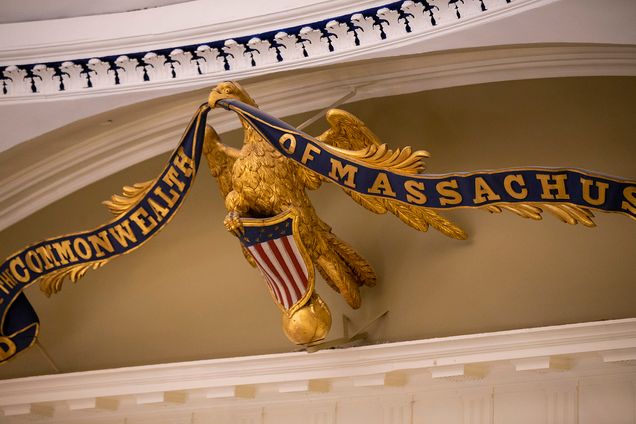 In an otherwise terrific book, one criticism is David consistently referred to Virginia as “the commonwealth.” This was confusing given that everyone knows that Massachusetts is the Commonwealth—and now we can both field criticism from the good people of Pennsylvania and Kentucky.
In an otherwise terrific book, one criticism is David consistently referred to Virginia as “the commonwealth.” This was confusing given that everyone knows that Massachusetts is the Commonwealth—and now we can both field criticism from the good people of Pennsylvania and Kentucky.
In addition, I was left wanting more from the chapter on civic engagement. David’s prescription for better civic engagement is compelling, but he does not describe how we can change public behavior. He is probably right that a successful effort will happen at the state and local levels, but there are several looming questions: How do we improve civic education? How can attitudes change when polite discourse and compromise are viewed as signs of weakness by large segments of the population? This problem will only grow as authoritarianism becomes more popular, polarization increases, and people live in media bubbles. In that vein, aren’t uncivil legislators just reflecting what their constituents want? What can the government do and what are its limits?
These are difficult questions, and I do not have answers. Perhaps David does and can write a follow-up book—I would be excited to read it.
Here Comes the Sun?
On March 12, 2021, a bipartisan coalition of Senators reintroduced the Sunshine Protection Act, a bill that would make daylight saving time permanent across the country. Leading sponsors include Ed Markey (D-Mass.) and Marco Rubio (R-Fla.). This legislation would not only eradicate the disruption created by changing our clocks twice a year, but would also result in more afternoon and evening daylight for everyone around the country. This is not the first attempt to make daylight saving time permanent; bills to end the time changes have been introduced in Congress and in state legislatures with little success. A similar bill was introduced in the Senate in 2019. In 2019 and 2020, thirty-two states, including Massachusetts, proposed legislation to make daylight savings permanent.
Daylight Saving in the United States
Daylight saving was instituted in America during World War I. Germany became the first country to institute the change in 1916
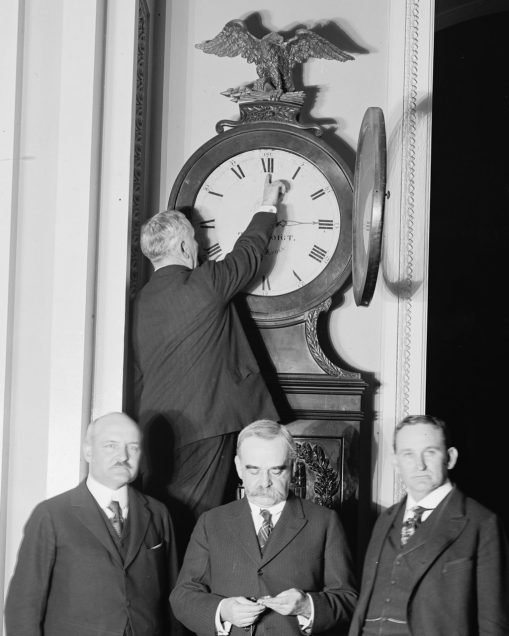
Ohio Clock in the U.S. Capitol being turned forward for the first U.S. daylight saving time on March 31, 1918.
as a way to conserve fuel. England and America followed shortly after in 1918, believing that more daylight during the workday would reduce coal usage and thus save energy. Evidence that it saves energy is slim, however, as lighting has become increasing energy efficient.
President Woodrow Wilson wanted to keep daylight savings after the war ended, but anecdotally received pushback from farmers who would lose an extra hour of light in the morning. The darker mornings made it more difficult for them to get their products to market, and often negatively affected their livestock. It was eventually abolished, but then reinstated by President Roosevelt during World War II.
After World War II ended, states retained the power to decide whether to observe daylight saving time. In 1966, Congress enacted the Uniform Time Act for states that had chosen to observe daylight saving. The Act designated uniform dates on which daylight saving would begin, so as to prevent confusion in travel and broadcasting.
Let the Sunshine in
The time has come to make daylight saving permanent. Changing our clocks twice a year causes unnecessary stress and confusion, and losing valuable daylight in the dreary winter months is an unwelcome side effect.
First, research has shown that changing our clocks in the fall contributes to an increase in Seasonal Affective Disorder among the population. Scientists believe that shorter days and reduced sunlight in the winter trigger biochemical changes in the brain. Many have even suggested light therapy (exposure to a light box that simulates high-intensity sunlight) as treatment for depressive disorders. The effects of darkness on our mental health have only been worsened by the COVID-19 pandemic. Many people who found solace in evening walks, exercising, or general outdoor time lost those outlets and motivation when they lost daylight in November. Making daylight saving permanent would improve our mental health by increasing opportunities to get sunlight every day, and by providing more time for healthy outdoor activities.
 Second, eliminating time changes would have a number of other health and safety benefits. Aligning daylight with workers’ standard hours would increase visibility during busy driving times, helping prevent crashes. Additionally, research has shown that the number of car crashes spike in the week following the spring time change. Abolishing the change would eliminate the stress and confusion that accompanies sudden changes to work schedules. Furthermore, making daylight saving permanent would shift busy driving hours away from certain animals’ nocturnal hours, thereby reducing vehicle collisions with wildlife. Research has also suggested that transitions in and out of daylight saving time disrupt circadian rhythms and lead to increased risk for heart attacks and strokes. More daylight in the evenings also reduces your risk of being the victim of a robbery.
Second, eliminating time changes would have a number of other health and safety benefits. Aligning daylight with workers’ standard hours would increase visibility during busy driving times, helping prevent crashes. Additionally, research has shown that the number of car crashes spike in the week following the spring time change. Abolishing the change would eliminate the stress and confusion that accompanies sudden changes to work schedules. Furthermore, making daylight saving permanent would shift busy driving hours away from certain animals’ nocturnal hours, thereby reducing vehicle collisions with wildlife. Research has also suggested that transitions in and out of daylight saving time disrupt circadian rhythms and lead to increased risk for heart attacks and strokes. More daylight in the evenings also reduces your risk of being the victim of a robbery.
Third, making daylight saving permanent would have economic benefits. Studies have shown that economic activity drops when the clocks move back. Making daylight saving permanent could help prevent this drop as consumers are more likely to go out shopping if it is still light out. The time change also affects the agriculture industry. Contrary to common belief, farmers are not advocates for changing our clocks—the change actually hurts them. The myth that daylight saving originated in order to help them has been dispelled. Making daylight saving permanent would benefit the agriculture industry as changing clocks disrupts the synergy between farmers and their supply-chain partners.
The Dark Side?
Having more daylight in the afternoons would inevitably mean less daylight in the mornings. But with the increasing opportunities for remote work and school, this may not be as big of a problem for many.
Some businesses are also not fond of the idea. Television networks dislike the extra sunlight because ratings suffer during daylight savings due to people spending more time outside, especially during important time slots like the 8 p.m. hour. However, other prominent industries like airlines and Amtrak, prefer one permanent time because changing clocks causes major scheduling problems, especially when coordinating international travel.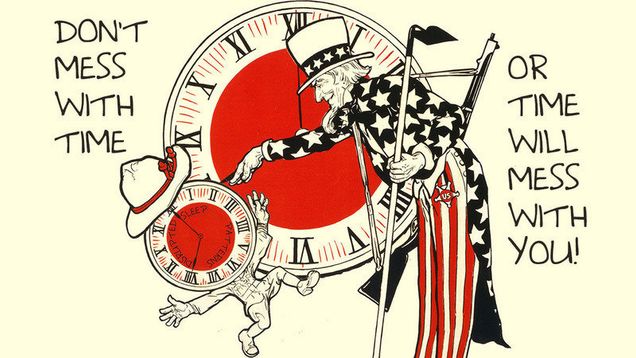
Additionally, a change like this might be too difficult for a state to make independently, which heightens the importance of this federal bill. For example, Massachusetts ultimately decided that it could not make the change alone; it would need other northeastern states to join in order to avoid large disruptions to travel and broadcast schedules. A uniform federal bill would solve many of the problems that state legislators encounter when trying to make daylight savings permanent in their states.
Conclusion
As the COVID-19 pandemic confined people to their homes and away from others, many began to value their time spent outside as much needed entertainment and relaxation. When we turned our clocks back in November and lost precious daylight, the effects of being stuck inside became even more prominent. The Sunshine Protection Act is being reintroduced at an important time, considering this will likely not be the last pandemic we see in our lifetimes. Congress should recognize the harm that this outdated tradition causes, and finally agree to let the sunshine in.
 Alina Cathcart anticipates graduating from Boston University School of Law in May 2022.
Alina Cathcart anticipates graduating from Boston University School of Law in May 2022.
Never Too Early to Save a Child’s Life: Eating Disorders Prevention in Schools Act of 2020
Eating disorders have the second highest mortality rate of any mental illness, second only to opioid overdose. 1 in 5 women (19.7%) and 1 in 7 men (14.3%) will suffer from an eating disorder. Not only are eating disorders potentially life-threatening, eating disorders can carry devastating long-term consequences on both physical and mental “health, productivity, and relationships.” These disorders can also be indications of co-occurring mental conditions that will worsen over time without proper treatment. Early screening and intervention are imperative to addressing and abating these long-term effects. Congress can address this difficult public health problem by passing the Eating Disorders Prevention in Schools Act.
 Eating disorders can affect all individuals regardless of body size, age, gender, or race; however, BIPOC teenagers, LGBTQ+ individuals, disabled individuals, overweight individuals, athletes, and veterans are at an increased risk of developing an eating disorder. The majority of eating disorders develop during adolescence and young adulthood, with high recurring rates later in life. Targeted prevention efforts for young individuals remain critical to reduce eating disorder-related mortality and complications.
Eating disorders can affect all individuals regardless of body size, age, gender, or race; however, BIPOC teenagers, LGBTQ+ individuals, disabled individuals, overweight individuals, athletes, and veterans are at an increased risk of developing an eating disorder. The majority of eating disorders develop during adolescence and young adulthood, with high recurring rates later in life. Targeted prevention efforts for young individuals remain critical to reduce eating disorder-related mortality and complications.
Disordered eating and body dissatisfaction, common risk-factors associated with eating disorders, are highly prevalent among children and young adults. Expectations to be thin begin at a very young age: 42% of 1st to 3rd grade girls desire to be thinner and 81% of 10 year old children report fears of being fat. Subsequently, dieting begins at a very young age: 46% of children ages 9-11 report that they are “sometimes” or “very often” on diets; 35-57% of adolescent girls engage in dangerous behaviors such as “crash dieting, fasting, self-induced vomiting, diet pills, or laxatives”; and 91% of college-aged women report dieting to control their weight. The American Academy of Pediatrics strongly discourages young people from dieting, especially without active involvement and support from family and clinical supervision by a pediatrician. Studies show that dieting is counterproductive to maintaining a healthy lifestyle and “teenagers with no weight problem will gain weight due to weight loss attempts." Most importantly, however, dieting can predispose individuals to eating disorders and reinforce the “normative discontent” around body dissatisfaction that greatly increases maladaptive health behaviors and psychological stress.
Eating Disorders Prevention in Schools Act
To address this alarming public health issue, Representative Alma Adams (D-NC-12) and Representative Vicky Hartzler (R-MO-04) introduced the bipartisan Eating Disorders Prevention in Schools Act of 2020 in the U.S. House of Representatives on May 6, 2020. The bill is currently referred to the House Committee on Education and Labor. If passed, this Act will require school districts to develop school nutrition programs and physical activity programs in a way that will help prevent disordered eating and eating disorders. The goal of the Act is to improve overall health outcomes for all children. In the bill’s press release, Representative Adams noted the urgency of passing this legislation stating that “[a]s students across the country face disruptions, stress, and anxiety due to COVID-19, all of which exacerbate mental illnesses like eating disorders, the need for this legislation grows increasingly clear.”
The Eating Disorders Prevention in Schools Act has the support of the National Eating Disorders Association (“NEDA”), the largest nonprofit organization dedicated to supporting those affected by eating disorders. Chevese Turner, NEDA’s Chief Strategy & Policy Officer, advocated for the legislation stating that it “is an important step forward in eating disorders prevention and early identification efforts . . . Schools are uniquely positioned to play a part in this increasingly significant public health issue that has the second highest mortality rate of any mental health disorder and will affect over 30 million people in their lifetime in the US alone.”
The bill specifically requires local educational agencies that participate in school lunch or breakfast programs to “include goals for  reducing disordered eating in children of all sizes in their local school wellness policies.” The Department of Agriculture will be required to provide information and technical assistance to local educational agencies, school food authorities, school health professions, and state educational agencies. This assistance must promote eating disorder prevention, encourage eating disorder screening, and help establish healthy school environments. One of the most important aspects of this bill is that in developing, implementing, and reviewing school wellness policies, local educational agencies must involve registered dietitians and licensed mental health professionals.
reducing disordered eating in children of all sizes in their local school wellness policies.” The Department of Agriculture will be required to provide information and technical assistance to local educational agencies, school food authorities, school health professions, and state educational agencies. This assistance must promote eating disorder prevention, encourage eating disorder screening, and help establish healthy school environments. One of the most important aspects of this bill is that in developing, implementing, and reviewing school wellness policies, local educational agencies must involve registered dietitians and licensed mental health professionals.
The Eating Disorders Prevention in Schools Act could be an important catalyst to implementing eating disorder prevention and screening programs in schools across the United States. It is vital that the bill maintains its requirement that registered dietitians and licensed mental health professionals be involved in the creation of school policies. In addition, for the intended goals of this legislation to be successful, these registered dietitians and licensed mental health professionals need to specialize in eating disorder treatment, a highly delicate and nuanced field.
Not all dietitians and mental health professionals understand the severity of weight-bias in the treatment of eating disorders. Studies show that even gentle conversations discussing “healthy eating” can lead children to interpret the message very strictly leading to the adoption of rigid rules regarding good foods versus bad foods. Programs and policies developed to address disordered eating and eating disorders need to be carefully crafted to avoid unintentional consequences stemming from discussing weight, eating, and exercise in a way that could lead a child to develop maladaptive behaviors. Prevention efforts should take the focus away from weight and healthy eating, and instead focus on joyful movement and body acceptance.
The Eating Disorders Prevention in Schools Act is a positive step towards addressing a significant public health problem. The Act could help a large portion of the next generation avoid developing a life-threatening and devastating mental illness. It is imperative, however, that clinicians specializing in eating disorders remain a significant part of the conversation when schools attempt to implement these prevention programs. Discussing weight, eating, or exercise is a delicate subject that can sometimes cause more harm than good. With the right training and policies in place, schools can change the narrative around weight and body image and make a positive impact on the overall health of its students. The Eating Disorders Prevention in Schools Act can help make this vision a reality.
 Jessa Boubker graduated from Boston University School of Law and Boston University School of Public Health with a JD/MPH in May 2021.
Jessa Boubker graduated from Boston University School of Law and Boston University School of Public Health with a JD/MPH in May 2021.
Wearables and the FDA: Lessons from the COVID-19 Pandemic
When the COVID-19 pandemic upended the entire world in March 2020, many industries were thrown in chaos. With the limitations on capacity in gyms across many states, technologies such as the Apple Watch or Fitbit (collectively called “Wearables”) became increasingly popular. Wearables are devices that track activities and record information about the person’s movements using sensors. Early models had simple uses like counting a user’s steps throughout the day. As the devices became more sophisticated, wearables quickly transformed into powerful tools that could monitor physical activity, sleep patterns, calories burned, and even blood pressure.
FDA Regulation of Medical Devices
 In 1938, Congress passed the Federal Food, Drug, and Cosmetic Act that provided the Food and Drug Administration (“FDA”) the authority to regulate medical devices. According to the Medical Device Regulation Act, the FDA regulates devices based on the potential risk of harm from the device, classifying devices as Class I, Class II, and Class III. Class I devices have a low risk of harm to patients while Class III devices are high risk. As the class of device increases, the FDA imposes more regulatory controls to ensure the device is safe and effective. In 2016, the 21st Century Cures Act (the “Cures Act”) clarified that certain digital software intended for low-risk general wellness purposes should be excluded from the statutory definition of a device. Low-risk general wellness software is defined as software features intended to help consumers maintain or encourage a healthy lifestyle and is not related to the diagnosis or treatment of a disease or condition.
In 1938, Congress passed the Federal Food, Drug, and Cosmetic Act that provided the Food and Drug Administration (“FDA”) the authority to regulate medical devices. According to the Medical Device Regulation Act, the FDA regulates devices based on the potential risk of harm from the device, classifying devices as Class I, Class II, and Class III. Class I devices have a low risk of harm to patients while Class III devices are high risk. As the class of device increases, the FDA imposes more regulatory controls to ensure the device is safe and effective. In 2016, the 21st Century Cures Act (the “Cures Act”) clarified that certain digital software intended for low-risk general wellness purposes should be excluded from the statutory definition of a device. Low-risk general wellness software is defined as software features intended to help consumers maintain or encourage a healthy lifestyle and is not related to the diagnosis or treatment of a disease or condition.
However, a device’s intended use can be hard to define. Intended use refers to the objective aim for the purpose of device. The FDA has a longstanding policy that all relevant evidence can be used to determine intended use including labeling, advertisements, and oral and written statements. However, companies use different marketing tactics, including both general and very specific messaging, to make their devices standout which can leave the intended use of a device up to interpretation.
Wearables and FDA regulation
As the capabilities of wearables increased, the FDA has grappled with how to regulate the new technology. Originally, wearables  were not considered medical devices unless they made claims about treating specific diseases or conditions. However, as the technology of wearables advanced, the FDA regulated some new features. For instance, Apple released an EKG feature on its watch to detect Atrial Fibrillation. Since it was meant to detect Atrial Fibrillation (an irregular heartbeat), Apple could not classify the feature as a general wellness device and the feature needed to be FDA cleared.
were not considered medical devices unless they made claims about treating specific diseases or conditions. However, as the technology of wearables advanced, the FDA regulated some new features. For instance, Apple released an EKG feature on its watch to detect Atrial Fibrillation. Since it was meant to detect Atrial Fibrillation (an irregular heartbeat), Apple could not classify the feature as a general wellness device and the feature needed to be FDA cleared.
Wearables and the COVID-19 pandemic
In the early days of the COVID-19 pandemic, a N.Y. Times Op-Ed advocated for the general public to use pulse oximeters to monitor their blood oxygen levels in hopes of detecting potential COVID-19 cases earlier. In September, Apple released a new pulse oximeter feature for its watch to allow people to monitor their blood oxygen levels. However, unlike the EKG feature, Apple marketed the new feature as a general wellness device. This allowed Apple to avoid FDA regulation. Any mention by Apple of the device’s ability to detect, diagnose or treat a specific condition or disease would mean that the device is subject to FDA regulation. To avoid being subject to FDA regulation, during the launch video, Apple executives discussed the general importance of pulse oximeters in detecting COVID-19, failing to mention the new feature was not FDA cleared for the purpose of detecting COVID-19.
The FDA should regulate these new wearable features because these new functions are not general wellness low-risk devices. Although Apple did not directly promote the pulse oximeter feature to detect COVID-19, Apple hints that the device can do this despite the lack of FDA clearance or approval. If the FDA lets this type of marketing go unchecked, they risk a “regulatory arbitrage” where companies design their devices to avoid costly clinical trials to prove safety and efficacy and instead promote devices as purely general wellness devices. Not only is this dangerous to consumers because the devices may not be effective for those purposes, but society may suffer as companies settle for simple devices rather than pushing to invent new technology.
In terms of risk level, the pulse oximeter is not low risk for two reasons. First, the FDA has released guidance documents stating that stand alone pulse oximeters should be classified as a Class II device. As a Class II device, the FDA considers pulse oximeters as medium to moderate risk devices. A feature in the Apple Watch (or other wearables) should not be subject to less regulation simply because it is part of a larger device. Second, the device could affect people’s decision to seek care despite the device’s documented inaccuracy. If the pulse oximeter feature shows normal blood oxygen levels, but in reality, a person has low blood oxygen levels, they might delay seeking care. This delay could have deadly consequences. Additionally, the device could mistakenly show low blood oxygen levels causing additional anxiety and emotional anguish during a period that has been incredibly hard for many people’s mental health.
The FDA’s role is to ensure medical devices on the market are safe and effective. However, some people argue that the FDA unnecessarily slows down products’ ability to enter the market stifling innovation. In this situation, some argue that a potentially helpful device, like the pulse oximeter on the Apple Watch, should reach the market as soon as possible and that market forces are sufficient to regulate new devices. The FDA is exploring this option through the launch of the Digital Health Software Precertification Program. Unlike the current system, the program would certify companies based on their comprehensive development and validation processes rather than focusing on specific products. Although this program would allow the products to get to market quicker, the program is still being evaluated. Until this program is proven effective, the FDA should not cede regulatory power to companies especially during a global pandemic.
Moving Forward
Although the FDA could exercise its regulatory power over the wearable industry, a more permanent solution is to update the Food, Drug and Cosmetic Act. Many products on the market, especially in the wearable industry, include different software features that could qualify as medical devices. Our laws regulating medical devices should be updated to reflect this possibility. Congress should clarify that any software feature, whether included in a larger device or not, will be regulated based on its intended uses and risk level to consumers. Additionally, Congress should codify the FDA’s longstanding policy of using all available evidence and define intended use. This will keep manufacturers of products honest about the capabilities of a feature so they do not market a type of software generally for a specific purpose that it may not be FDA approved or cleared for.
 Alex Maulden anticipates graduating from Boston University School of Law in May 2022.
Alex Maulden anticipates graduating from Boston University School of Law in May 2022.
Food, Drug and Cosmetic Act

